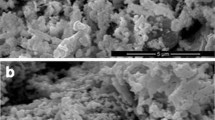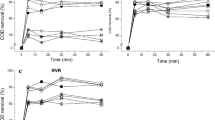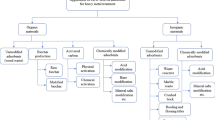Abstract
Water, soil and sediment contaminated with DDT poses a threat to the environment and human health. Previous studies have shown that zerovalent iron (ZVI) can effectively remediate water contaminated with pesticides like DDT, metolachlor, alachlor. Because the type of iron can significantly influence the efficiency and expense of ZVI technology, finding a cheaper and easily available iron source is one way of making this technology more affordable for field application. This study determined the effects of iron source, solution pH, and presence of Fe or Al salts on the destruction of DDT. Batch experiments demonstrated successful removal of DDT (>95% in 30 d) in aqueous solutions by three different iron sources with the following order of removal rates: untreated iron byproduct (1.524 d−1) > commercial ZVI (0.277 d−1) > surface-cleaned iron byproduct (0.157 d−1). DDT removal rate was greatest with the untreated iron byproduct because of its high carbon content resulted in high DDT adsorption. DDT destruction rate by surface-cleaned iron byproduct increased as the pH decreased from 9 to 3. Lowering solution pH removes Fe (III) passivating layers from the ZVI and makes it free for reductive transformations. By treating DDT aqueous solutions with surface-cleaned iron byproduct, the destruction kinetics of DDT were enhanced when Fe(II), Fe(III) or Al(III) salts were added, with the following order of destruction kinetics: Al(III) sulfate > Fe(III) sulfate > Fe(II) sulfate. Cost analysis showed that the cost for one kg of surface-cleaned iron byproduct was $12.33, which is less expensive than the commercial ZVI. Therefore, using surface-cleaned iron byproduct may be a viable alternative for remediating DDT-contaminated environments.
Similar content being viewed by others
References
Agrawal, A., & Tratnyek, P.G. (1996). Reduction of nitro aromatic compounds by zerovalent iron metal. Environmental Science and Technology, 30, 153–160.
Alowitz, M.J., & Scherer, M.M. (2002). Kinetics of nitrate, nitrite and Cr(VI) reduction by iron metal. Environmental Science and Technology, 36, 299–306.
Amonette, J.E., Workman, D.J., & Kennedy, D.W. (2000). Dechlorination of carbon tetrachloride by Fe(II) associated with goethite. Environmental Science and Technology, 34, 4606–4613.
Blowes, D.W., Ptacek, C.J., & Jabor, J.L. (1997). In situ remediation of Cr(VI)-contaminated groundwater using permeale reactive walls: Laboratory studies. Environmental Science and Technology, 31, 3348–3357.
Bolt, H.M., & Degen, G.H. (2002). Comparative assessment of endocrine modulators with oestrogenic activity. II Persistent organochlorine pollutants. Archives of Toxicology, 76, 187–193.
Comfort, S.D., Shea, P.J., Machacek, T.A., Gaber, H., & Oh B.-T. (2001). Field scale remediation of a metolachlor-contaminated spill site using zerovalent iron. Journal of Environmental Quality, 30, 1636–1643.
Dombek, T., Dolan, F., Schultz, J., & Klarup, D. (2001). Rapid reductive dechlorination of atrazine by zero-valent iron under acidic conditions. Environmental Pollution, 111, 21–27.
Eggen, T., & Majcherczyk, A. (2006). Effects of zero-valent iron (Fe0) and temperature on the transformation of DDT and its metabolites in lake sediment. Chemosphere, 62, 1116–1125.
Eykholt, G.R., & Davenport, D.T. (1998). Dechlorination of the chloroacetanilide herbicide alachlor and metolachlor by iron metal. Environmental Science and Technology, 32, 1481–1487.
Farrell, J., Kason, M., Melitas, N., & Li, T. (2002). Investigation of the long-term performance of zero-valent iron for reductive dechlorination of trichloroethylene. Environmental Science and Technology, 34, 514–521.
Fiedor, J.N., Bostick, W.D., Jarabek, R.J., & Farrel, J. (1998). Understanding the mechanism of uranium removal from groundwater by zero-valent iron using X-ray photoelectron spectroscopy. Environmental Science and Technology, 32, 1466–1473.
Gaber, H.M., Comfort, S.D., Shea, P.J., & Machacek, T.A. (2002). Metolachlor dechlorination by zerovalent iron during unsaturated transport. Journal of Environmental Quality, 31, 62–969.
Gillham, R.W., & O'Hannesin, S.F. (1994). Enhanced degradation of halogenated aliphatics by zero-valent iron. Groundwater, 32, 958–967.
Gregory, K.B., Larese-Casanova, P., Parkin, G.F., & Scherer, M.M. (2004). Abiotic transformation of hexahydro-1,3, 5-trinitro-1,3,5-triazine by FeII bound to magnetite. Environmental Science and Technology, 38, 1408–1414.
Hongtrakul, T., Chulintorn, P., Thangnipon W., & Sakulthiengtrong, S. (2005). POPs pesticides in Thailand' abstract, UNU International Symposium on Ecosystem Impacts of POPs, Bangkok, Thailand April 26–27, 2005.
Huang, Y.H., Zhang, T.C., Shea, P.J., & Comfort, S.D. (2003). Effects of oxide coating and selected cations on nitrate reduction by iron metal. Journal of Environmental Quality, 32, 1306–1315.
Johnson, T.L., Scherer, M.M., & Trantnyek P.G. (1996). Kinetics of halogenated organic compound degradation by iron metal. Environmental Science and Technology, 30, 2634–2640.
Kile, D. E., & Chiou, C. T. (1989). Water solubility enhancements of DDT and TCB by some surfactants below and above the critical micelle concentration. Environmental Science and Technology, 23, 832–838.
Klausen, J., Trober, S.P., Haderlein, S.B., & Schwarzenbach, R.P. (1995). Reduction of substituted nitrobenzenes by Fe(II) in aqueous mineral suspensions. Environmental Science and Technology, 29, 2396–2404.
Light, T.S. (1972). Standard solution for redox potential measurement. Analytical Chemistry, 44, 1038–1039.
Park, J., Comfort, S.D., Shea, P.J., & Machacek, T.A. (2004). Remediaitng munitions-contaminated soil with zerovalent iron and cationic surfactants. Journal of Environmental Quality, 33, 1305–1313.
Park, J., Comfort, S.D., Shea, P.J., & Kim, J.S. (2005). Increasing Fe0-mediated HMX destruction in highly contaminated soil with didecyldimethylammoniumbromide surfactant. Environmental Science and Technology, 39, 9683–9688.
Quensen III, J.F., Tiedje, J.M., Jain, M.K., & Mueller, S.A. (2001). Factors controlling the rate of DDE to DDMU in Palos Verdes Margin under anaerobic condition. Environmental Science and Technology, 35, 286–291.
Sakulthiengtrong, S., Wesyanon, M., Baiadul, P., & Hruth- aithanasun, P. (2002). Contamination of hazardous mater- ials in groundwater. Proceedings of 4th department of hazardous material conferences, Karbi, Thailand pp. 64–73.
Satapanajaru, T., Comfort, S.D., & Shea, P.S. (2003a). Enhancing metolachlor destruction rates with aluminum and iron salts during zerovalent iron treatment. Journal of Environmental Quality, 32, 1726–1734.
Satapanajaru, T., Shea, P.J., Comfort, S.D., & Roh, Y. (2003b). Green rust and iron oxide formation influences metolachlor dechlorination during zerovalent iron treatment. Environmental Science and Technology, 37, 5219–5227.
Sayles, D.G., You, G., Wang, M., & Kupferle, M.J. (1997). DDT, DDD, and DDE dechlorination by zerovalent iron. Environmental Science and Technology, 31, 3448–3454.
Schwertmann, U., & Cornell, R.M. (1991). Iron oxides in the laboratory. New York: VCH Publication.
Singh, J., Shea, P.J., Hundal, L.S., Comfort, S.D., Zhang, T.C., & Hage, D.S. (1998). Iron-enhanced remediation of water and soil containing atrazine. Weed Science, 46, 381–388.
Stookey, L.L. (1970). Ferrozine- a new spectrophotometric reagent for iron. Analytical Chemistry, 42, 779–781.
Till, B.A., Weathers, L.J., & Alvarez, P.J.J. (1998). Fe(0)-supported autotrophic denitrification. Environmental Science and Technology, 32, 634–639.
USEPA (United State Environmental Protection Agency). (1994). Method 8080A: organochlorine pesticides and polychlorinated biphenyls by gas chromatography. Washington, DC. USA: U.S. Environmental Protection Agency.
USEPA (United State Environmental Protection Agency) (1980). Ambient water quality criteria for DDT' EPA 440/5-80-038. Washington, DC. USA: U.S. Environmental Protection Agency.
WHO (World Health Organisation) (1989). DDT and its derivatives: Environmental aspects. Geneva, Switzerland: Environmental Health Criteria 83. WHO, pp. 6–11.
You, G.R., Sayles, G.D., Kupferle, M.J., Kim, I.S., & Bisphop, P.L. (1996). Anaerobic DDT biotransformation:enhancement by application of surfactants and low oxidation reduction potential. Chemosphere, 32, 226–2284.
Author information
Authors and Affiliations
Corresponding author
Rights and permissions
About this article
Cite this article
Satapanajaru, T., Anurakpongsatorn, P., Songsasen, A. et al. Using Low-Cost Iron Byproducts from Automotive Manufacturing to Remediate DDT. Water Air Soil Pollut 175, 361–374 (2006). https://doi.org/10.1007/s11270-006-9143-9
Received:
Accepted:
Published:
Issue Date:
DOI: https://doi.org/10.1007/s11270-006-9143-9




